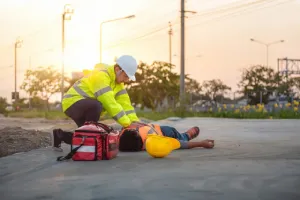Securing the Area to Prevent Further Accidents
When a slip, trip or fall happens, your job as a security officer doesn’t stop at helping the injured person. Equally important is securing the area to make sure no one else gets hurt. After all, one accident is unfortunate—two or three in the same place looks like negligence.
Think of it this way: you’re not just responding to an incident, you’re protecting everyone else in the environment from becoming the next casualty.

Why Securing the Area Matters
According to the HSE, slips and trips account for over one-third of all major workplace injuries in the UK. The biggest problem isn’t just the first fall—it’s that the same hazard often remains in place, causing multiple injuries in quick succession.
Example: In a shopping centre, a customer slips on a spilt drink. Before security can intervene, two more people fall in the same spot. What was originally a single incident quickly turns into a chain reaction.
As a security officer, the way you handle the scene shows professionalism, protects the public, and helps your employer stay compliant with UK safety expectations.
Practical Steps to Secure the Area
Think of this as your action plan when a slip, trip or fall happens. Every step you take makes the site safer, reassures the public, and shows you’re in control.
1. Control Access Immediately
Your first job is to stop more people walking into danger. Act fast—every second counts.
Use cones, barriers, or tape if they’re nearby.
If you’ve got nothing else, use yourself: stand tall, make eye contact, and direct people away.
Your visible presence shows authority and calms the crowd—people trust you’ve got it under control.
Scenario: At a hotel lobby, a guest slipped near the reception desk. The officer stood between the hazard and oncoming foot traffic, guiding guests around until equipment arrived. Not one more person was hurt.
Tip: No cones? No problem. Chairs, bins, or even a jacket on the floor can mark the hazard temporarily—creativity beats hesitation.
2. Remove or Reduce the Hazard
Once the area is contained, deal with the danger itself. But remember—only if it’s safe for you.
Mop or absorb a spill if it’s small.
Pick up broken glass or objects with tools or gloves.
Call maintenance or cleaners for bigger jobs—don’t try to be a hero.
Scenario: In a depot, an officer spotted loose cardboard sheets. Instead of dragging them alone, he radioed the loading team for help. The hazard was cleared quickly without risk.
Tip: Your safety comes first. Gloves, grabbers or mops exist for a reason—never handle sharp or dirty hazards barehanded.
3. Warn Others
Even if you’re working on the hazard, people still need to see and hear the warning.
Place wet floor signs or “Do Not Enter” boards where people will notice.
Use your radio or PA to alert colleagues—safety is a team effort.
Don’t be afraid to repeat yourself. Calm repetition is more effective than raising your voice.
Scenario: A supermarket guard noticed customers ignoring a “Wet Floor” cone. He politely repeated: “Please take the other aisle, this floor is slippery.” Clear, steady instructions kept everyone safe.
Tip: People often walk on “autopilot”. Speak clearly, point to the hazard, and guide them—it works better than just standing there.
4. Assist the Casualty Safely
Securing the area is important, but never forget the person already hurt.
Move them to safety if it’s possible without causing further harm.
If not, protect them by securing the space around them.
Offer calm reassurance: “Help is on the way, you’re safe here.”
Scenario: At a busy entrance, an officer found an injured shopper on a wet tile. Moving them risked further harm, so he created a safe perimeter until paramedics arrived.
Tip: Casualty first, but safety always—don’t risk lifting or moving someone if you’re unsure. Protect the space instead.
5. Document and Report
The incident doesn’t end when the hazard is gone. Your record is proof of professionalism, compliance, and protection for you and your employer.
Log what happened, what you did, and when.
Be specific: sizes, times, actions. Avoid vague descriptions.
Report quickly to your supervisor or health & safety contact.
Scenario: An officer logged: “Soft drink spill, approx. 1.5m, identified 13:20, contained with cones, cleaned by housekeeping at 13:28.” That precision protected both the company and the officer when questioned later.
Tip: Facts beat guesses. “Spillage approx. 2m x 1m, cleaned at 14:35” is professional; “floor was wet” is weak.
Real-World Scenario
On a busy Monday morning, an employee slipped on rainwater near the office entrance. The security officer quickly reassured the casualty, placed a wet floor sign, and redirected foot traffic while arranging cleaning. Their fast action prevented further accidents and kept the reception calm—earning praise for professionalism.
Tip: Acting quickly and visibly not only protects others but also shows your value as a trusted security professional.
Consequences of Not Securing the Area
Failing to act doesn’t just look unprofessional—it can spiral into serious harm, chaos, and lasting damage. Here’s what’s at stake:
Casualty impact: The injured person could be struck again if others stumble into the same hazard, turning a minor fall into a major medical emergency.
For others: One slip often leads to another. A single puddle or obstacle can cause multiple accidents in minutes, sparking panic and confusion.
Professional risk: If you ignore the hazard, investigators may call it negligence. That could mean losing your SIA licence—and with it, your career.
Employer risk: Each unchecked hazard exposes your company to legal claims, hefty fines, and a damaged reputation that no “sorry” can repair.
Tip: A few seconds of action—blocking access, warning others, calling for help—can save hours of paperwork, investigations, and sleepless nights later.
Managing Bystanders and Crowds
Accidents attract attention—people stop, gather, and sometimes get in the way. A small crowd can easily block emergency access or even create new hazards. Your role is to keep the scene safe and controlled.
Example: In a train station, a passenger slipped on spilled coffee. A crowd gathered, making the area congested. The officer politely directed onlookers away and created a clear path for paramedics, preventing further risk.
Tip: Use calm, professional language: “Please step back for safety; we need to keep this area clear.” Authority plus reassurance works better than shouting.
Coordinating with Other Teams
You’re not alone in managing accidents—cleaning teams, first aiders, supervisors, and even external responders all play a part. Knowing how to coordinate makes the response smoother and faster.
Example: In a retail park, an officer secured a wet floor after rainwater pooled inside the entrance. Instead of trying to fix everything alone, he called cleaning staff, updated management, and guided shoppers away until the hazard was resolved.
Tip: Always keep your radio communication short and structured: “Slip hazard, main entrance, spill approx. 3 metres, cleaning needed urgently.” Clarity avoids confusion and speeds up response.
Key Considerations for Officers
In any slip, trip, or fall, your role goes beyond just reacting—you’re the calm centre holding everything together. To succeed, remember to:
Balance priorities: Care for the casualty while still controlling the hazard. Safety for one shouldn’t create risk for others.
Control the scene: Manage bystanders and crowds with authority but professionalism, keeping access clear for emergency teams.
Work as a team: Coordinate with cleaners, first aiders, supervisors, or external responders—smooth teamwork speeds up recovery.
Lead with presence: Standing calm, visible, and confident reassures the public and shows you’re in charge.
Reflection: Imagine a busy Saturday in a shopping centre. A shopper has slipped. How would you split your focus—reassuring the casualty, keeping the crowd safe, and linking with staff—all at once? The answer defines you as a professional security officer.

